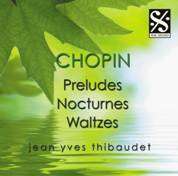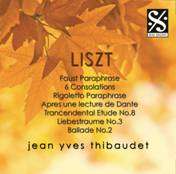|
Back
05/02/2011
Fryderyk Chopin: 24 Preludes, Op. 28 – Nocturnes, Op. 9 Nos. 1 & 2, & in C sharp minor, Op. posth. – Waltzes, Op. 34 & in A minor, Op. posth.
Jean-Yves Thibaudet (piano)
Recording information not provided – 73’59
Dal Segno #DSPRCD060 – Booklet in English

Franz Liszt: Faust Paraphrase, S. 407 – 6 Consolations, S. 172 – Rigoletto Paraphrase, S. 434 – Après une lecture de Dante, S. 161 – Etudes d'exécution transcendante, S. 139 – Liebestraum No. 3, S. 541 – Ballade No. 2, S. 171
Jean-Yves Thibaudet (piano)
Recording information not provided – 70’12
Dal Segno #DSPRCD061 – Booklet in English

2010 and 2011 mark the bicentenary anniversaries of Chopin and Liszt respectively and see a profusion of releases of these two Romantic pianist-composers. Achieving a high standard both by the performer and the recording company is thereby the essential quality that a recording has to possess in order to outstrip its great many rivals. The selling point of the two new releases by Dal Segno is of course their newly signed artist Jean-Yves Thibaudet, who joined from Decca just a couple of months ago. In addition, a large portion of the recorded works in these two discs has never featured prominently in the repertoire of the French pianist who, in his Decca years, devoted his central focus on French impressionistic composers such as Debussy and Satie.
The recording of Chopin encompasses the complete cycle of Preludes Op. 28, plus three of the most popular Nocturnes and four Waltzes. Its enchantment stems from Mr. Thibaudet’s eccentric interpretation of all three genres, particularly the Preludes. In those more expressive and melancholic ones such as the Nos. 4, 15, 17, and 19, Mr. Thibaudet, unlike most pianists who dwell in the realm of Chopin’s sheer expressivity and buoyancy, employs exceptionally steady and metronomic paces throughout. For ears attuned to a more kaleidoscopic treatment of Chopin’s enriched harmony and improvisatory flow, his readings sound rather plainspoken. Nonetheless, it is this sense of simplicity, purity, and serenity that makes his interpretation idiosyncratically engrossing. Through the wide spectrum of moods in these 24 miniatures, Mr. Thibaudet once again demonstrates his capability of being a prodigious mood painter. The deadly atmosphere and harsh tone make the A minor Prelude a genuine depiction of an eerie funeral march. The dreamy lanscapes in Nos. 10 and 23 sound as though there is a large-scale work to be ensued. However, his occasionally percussive tone comes across as jarring clatter in some fortissimo passages. Nos. 9 and 11 are cases in points.
Less impressive are the Nocturnes and Waltzes. Mr. Thibaudet’s sluggish pace and somehow metronomic steadiness makes the former too studied and the latter rhythmically heavy-footed. The composer’s trademark long-ranged melodic arching in the Nocturnes and light-hearted salon character in the Waltzes are the missing elements that the pianist shows limited interest in.
The disc of Liszt similarly encompasses some of the most popular repertoire of the composer, such as the two Paraphrases and the Third Liebestraum. Mr. Thibaudet is not the kind of pianists who impetuously indulge in glitzy virtuosity. Nonetheless, he inherited the uncontainable outbursts of glittering bravura that Liszt left to his successors – the technical hurdles in the two Paraphrases that he jumped through with aplomb are the best exemplifications.
Instead of merely showing off his infallible fingers, the French pianist makes no compromise to the music’s rhetoric elements by intertwining the most visceral excitement with the plenty of poetic refinement. The Six Consolations, presented in one track, are rendered with briefest pauses so that they somehow come across as a cohesive tonal palette. The emotional contrasts in the Apres une lecture de Dante and the Second Ballade are also trenchantly unveiled.
What is most disappointing comes from, surprisingly, the texts of these two releases. Erroneously stating in the program leaflet that Chopin’s Preludes are ‘lack of formal thematic structure’ is unsatisfactory. Even more inexcusable is the mistaken spelling of ‘Transcendental Etude’ as ‘Trancendental Etude’ both on the back cover and in the leaflet of the Liszt disc. The recording information – date, place, and so forth – is also of nowhere to be found in the sketchy booklets. These are areas Dal Segno may wish to improve in their upcoming releases.
Danny Kim-Nam Hui
|